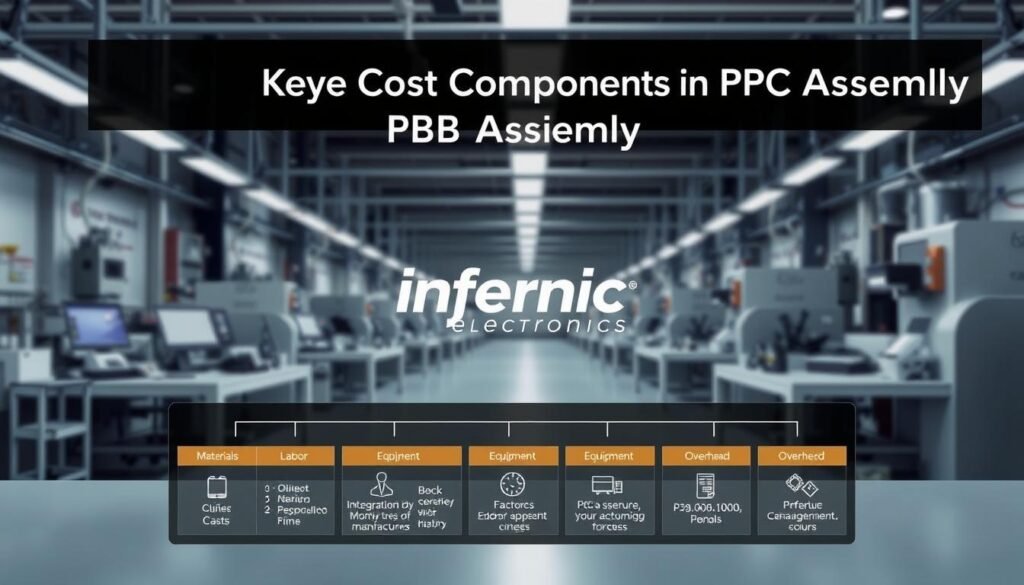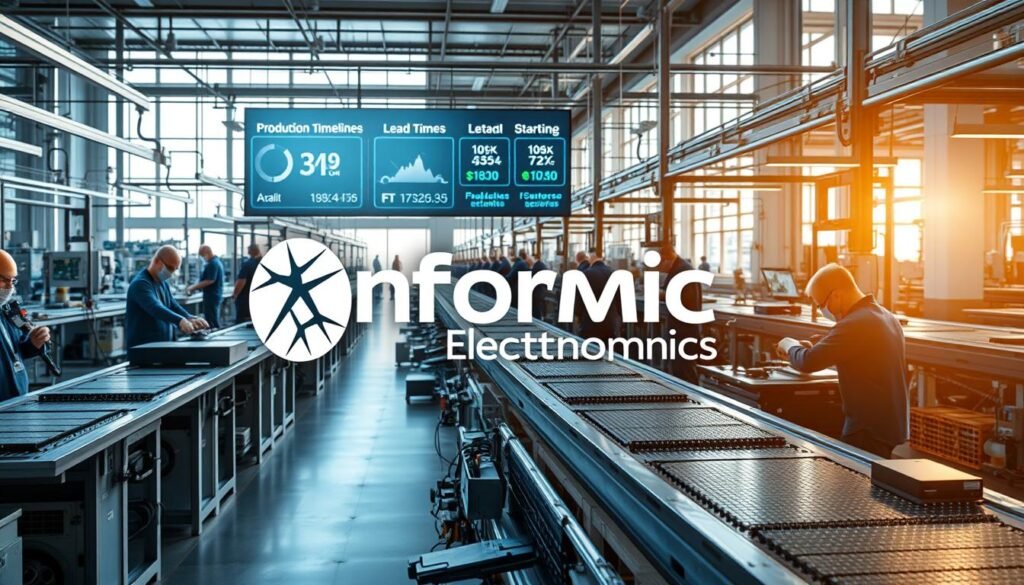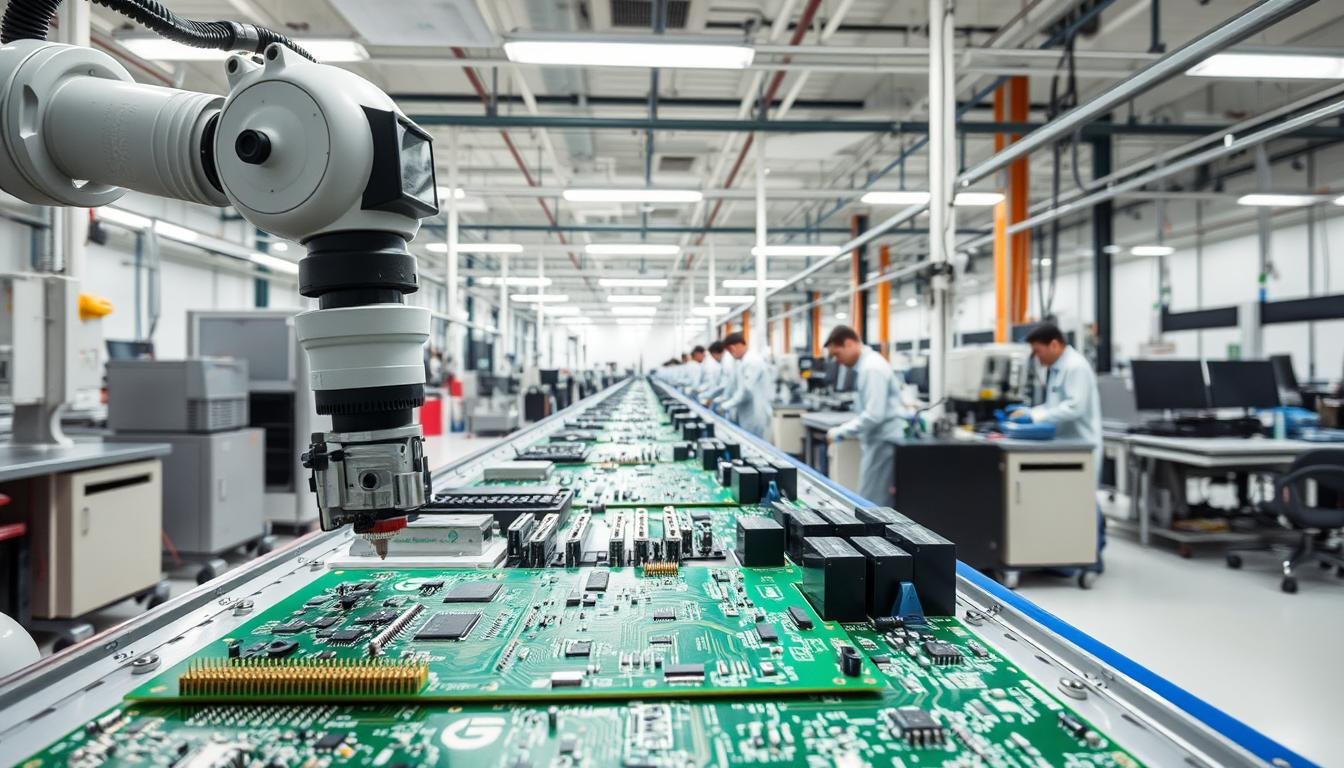Have you ever wondered why two nearly identical circuit boards can have wildly different production expenses? The answer lies in a complex dance between technical specifications and manufacturing realities. We analyze the hidden variables that transform straightforward projects into budget challenges.
Modern electronics creation involves four primary expense categories. Bare board fabrication sets the foundation, with material quality and layer count directly affecting pricing. Component procurement often becomes the heaviest financial burden, particularly for specialized parts.
Our experience shows that assembly techniques dramatically influence outcomes. Surface Mount Technology dominates modern production lines due to its speed and precision. However, projects requiring mixed assembly methods face unique cost considerations.
Testing protocols complete the financial picture. While essential for quality assurance, advanced inspection methods add layers to the budget. Strategic planning across these areas enables manufacturers to balance performance requirements with fiscal responsibility.
Key Takeaways
- Four core components shape production budgets: board fabrication, parts sourcing, assembly labor, and quality testing
- Component acquisition typically represents the largest single expense category
- Automated assembly methods optimize speed and reduce human error
- Board complexity exponentially increases both material and labor costs
- Strategic partner selection can yield significant savings without quality compromises
Introduction to PCB Assembly and Cost Considerations
Transforming electronic designs into functional products requires precision manufacturing techniques. At its core, this transformation relies on systematic component integration methods that balance technical requirements with economic feasibility.
Overview of PCB Assembly Processes
Modern production primarily uses Surface Mount Technology (SMT) for its speed and accuracy. Automated machines apply solder paste, position microscopic parts, and perform reflow soldering in controlled thermal environments. This approach supports compact layouts essential for today’s miniaturized devices.
Through-hole methods remain vital for components needing physical durability. Workers insert leads into pre-drilled holes before wave soldering creates permanent connections. “Hybrid configurations combining both techniques deliver optimal performance for complex designs,” notes our engineering team.
The Importance of Cost Analysis in Electronics Manufacturing
Strategic financial planning starts during prototype development. Component selection directly affects 60-70% of total expenses, particularly for specialized ICs or low-availability parts. Automated optical inspection systems prevent costly rework by catching defects early.
We prioritize design-phase cost simulations that model different production scenarios. This proactive approach identifies potential savings in material choices, assembly workflows, and testing protocols without sacrificing reliability.
Key Cost Components in PCB Assembly

Understanding where your manufacturing budget goes requires dissecting four fundamental expense categories. Each plays a distinct role in determining final pricing while maintaining quality standards.
Bare Board, BoM, and Assembly Charges
Base material selection dictates initial expenses. Multi-layer designs using FR-4 substrates typically cost 40% more than single-layer alternatives. Complete design files ensure accurate fabrication quotes.
Component acquisition often consumes 65-75% of total budgets. Bill of Materials (BoM) complexity drives this expense, especially for specialized integrated circuits or connectors with long lead times. We recommend building 8-12% material buffers to account for supply chain fluctuations.
| Cost Component | Key Factors | Typical Cost Impact |
|---|---|---|
| Bare Board | Layer count, material grade | 15-25% |
| Components | BoM complexity, availability | 60-75% |
| Assembly | SMT vs through-hole mix | 10-20% |
Testing, Packaging, and Logistics
Quality verification adds 5-15% to project costs. Automated optical inspection catches 98% of defects early, reducing rework expenses. Functional testing protocols vary by application complexity.
Protective conformal coatings increase durability but add 3-7% to budgets. EMI-shielded packaging solutions cost 2-4x standard options. Expedited shipping can double logistics expenses compared to standard timelines.
| Additional Service | Purpose | Cost Range |
|---|---|---|
| IPC-A-610 Testing | Quality certification | $500-$2,000 |
| Conformal Coating | Environmental protection | $0.15-$0.40/board |
| Express Shipping | 3-5 day delivery | +75-150% |
Critical Factors Influencing Assembly Costs
Manufacturing budgets fluctuate based on technical decisions made during product development. Three interconnected elements typically determine financial outcomes: structural challenges, parts selection, and regulatory demands.
Board Complexity and Design Variations
We observe that layer counts directly affect production timelines. Multi-layer designs require precise alignment and advanced lamination techniques. Thicker boards exceeding 2.4mm demand specialized drilling equipment, increasing setup costs by 18-25%.
| Design Factor | Cost Impact | Common Solutions |
|---|---|---|
| 8+ Layers | +35% Fabrication | Optimized stackup design |
| 0.3mm Drills | +20% Tooling | Laser drilling systems |
| Mixed Assembly | +15% Labor | Automated hybrid lines |
Component Count, Materials, and Quality Standards
High-density layouts with 500+ placements per board extend assembly time by 40%. Leadless packages like BGAs require X-ray inspection systems, adding $0.12-$0.30 per unit. Material choices create cost variations:
| Substrate | Cost Index | Typical Use |
|---|---|---|
| FR-4 | 1.0x | Consumer electronics |
| Polyimide | 3.2x | Aerospace systems |
| Ceramic | 5.8x | High-frequency RF |
Certification requirements add 7-12% to budgets. RoHS-compliant processes need separate production lines, while ISO 13485 medical standards mandate rigorous documentation. We recommend balancing these factors during initial prototyping phases.
PCB Assembly Cost Factors: A Comprehensive Breakdown

Manufacturing efficiency hinges on strategic scheduling and technology selection. Two critical variables often determine budget outcomes: delivery urgency and batch sizes.
Impact of Lead Time and Build Volume
Rushed timelines create financial pressure. Expedited one-day services typically cost 50-80% more than standard 15-day production windows. Our data shows planning 30-45 days ahead reduces per-unit expenses by 18-22% through optimized material sourcing.
Batch quantities transform cost structures. Placing 10,000-unit orders cuts setup fees to less than 2% of total expenses versus 15% for 500-unit batches. We implement tiered pricing models where volume thresholds unlock discounts:
Role of Surface Mount Technology vs. Through-Hole Techniques
SMT dominates modern production with 90%+ component placement accuracy. Automated lines process 25,000 placements hourly at $0.003 per joint. This scalability makes it ideal for compact, high-volume designs.
Through-hole methods remain vital for heavy connectors or high-voltage parts. While costing 3x more per connection, these techniques provide unmatched mechanical strength. Our engineers recommend hybrid approaches for complex boards needing both precision and durability.
Smart scheduling combined with technology matching creates optimal cost profiles. We’ve achieved 37% savings for clients by aligning order volumes with manufacturer capacity windows and SMT capabilities.
Strategies for Cost Reduction and Production Optimization
Smart production strategies transform technical designs into financially viable products. We implement proven methods that address both assembly cost drivers and operational efficiencies, creating sustainable savings throughout product lifecycles.
Design for Manufacturability (DFM) and Component Standardization
Early collaboration with manufacturing partners yields significant savings. Our DFM approach identifies potential issues in board layouts and material choices before production begins. Component standardization reduces unique part counts by 25-40% across projects, simplifying procurement and inventory management.
| Design Choice | Impact | Cost Benefit |
|---|---|---|
| Standardized components | Simplified sourcing | 12-18% savings |
| 4-layer vs 6-layer boards | Reduced fabrication time | 22% cost reduction |
| SMT optimization | Faster assembly | $0.002/placement |
Leveraging Order Consolidation and Automated Processes
Combining multiple orders into single production runs cuts setup fees by 35-50%. Automated SMT lines handle 30,000 components hourly with 99.98% accuracy, minimizing labor requirements. Our clients achieve 19% average savings through intelligent batching and panelization.
| Order Volume | Per-Unit Cost | Setup Fee Impact |
|---|---|---|
| 500 units | $4.20 | 15% |
| 5,000 units | $3.15 | 5% |
| 25,000 units | $2.40 | 2% |
Automated optical inspection systems validate quality while reducing manual checks by 80%. For detailed guidance on implementing these strategies, explore our proven cost reduction methods.
Choosing the Right PCB Assembly Manufacturer in the United States
Selecting the ideal production partner shapes both product success and financial outcomes. We prioritize three core evaluation criteria when matching projects with manufacturing partners: technical capability alignment, operational transparency, and geographic advantages.
Evaluating Quality, Turnaround Time, and Cost Transparency
Certified manufacturers with IPC-610 compliance reduce defect risks by 78% compared to uncertified operators. Demand detailed breakdowns of labor costs and material pricing – vague quotes often hide potential overages. Our clients save 12-19% annually by partnering with facilities offering real-time production tracking.
Domestic operations typically provide 3-5 day prototype cycles versus 14+ days overseas. While US labor costs run 30-50% higher, this investment buys responsive engineering support and tighter IP controls. “The right contract manufacturer becomes an extension of your team,” observes our lead procurement specialist.
Benefits of Local Manufacturing vs. Overseas Options
Proximity enables faster design iterations – critical when testing functional prototypes. Domestic partners resolve component shortages 40% quicker through established supplier networks. For complex builds requiring frequent adjustments, local manufacturers reduce communication delays that plague overseas collaborations.
Explore our comprehensive partner selection guide to balance price considerations with technical requirements. Strategic manufacturer relationships ultimately determine product viability and market success.
FAQ
How does board complexity affect manufacturing expenses?
What role does component selection play in total project costs?
How do build volume and lead time impact pricing?
What cost advantages does SMT offer compared to through-hole assembly?
Can design modifications reduce production expenses without sacrificing quality?
Why does domestic manufacturing often provide better cost control than overseas options?
About The Author
Elena Tang
Hi, I’m Elena Tang, founder of ESPCBA. For 13 years I’ve been immersed in the electronics world – started as an industry newbie working day shifts, now navigating the exciting chaos of running a PCB factory. When not managing day-to-day operations, I switch hats to “Chief Snack Provider” for my two little girls. Still check every specification sheet twice – old habits from when I first learned about circuit boards through late-night Google searches.
